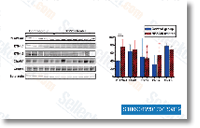Bioinformatic characterization of SSPLA2 The PANTHER Classification Process recognized this professional tein as a member in the cytosolic phospholipase A2 household with an really sig nificant E worth of 6. 4 e 97, BLAST evaluation with the derived amino acid sequence in the S. schenckii SSPLA2, showed a phospholipase domain extending from amino acids 177 to 750, Pfam examination demonstrates very similar effects, and within this domain the PLA2 signature GXSG is current as GVSGS while in the energetic web-site, The Western Blots results from SSG 2 SSPLA2 co immunoprecip main anti cMyc antibody was not extra, Lane 3 shows the band obtained employing anti HA anti physique that recognizes the authentic SSPLA2 fragment isolated in the yeast two hybrid clone. This band is within the expected size looking at that only the last 162 amino acids on the protein have been current and that this fragment was fused for the GAL four activation domain.
Lane four exhibits the outcomes obtained in the Western blot when the principal anti HA antibody was not extra, Sequencing of selleckchem erismodegib the sspla2 gene Figure 4A shows the sequencing approach implemented to the sspla2 gene. The DNA sequence of sspla2 gene was completed making use of genome strolling and PCR. Figure 4B exhibits the genomic and derived amino acid sequence with the sspla2 homologue. The genomic sequence has 2648 bp with an open studying frame of 2538 bp encoding an 846 amino acid protein that has a predicted molecular excess weight of 92. six kDa. The GenBank numbers to the genomic and derived amino acids wanted for catalytic exercise R235, S263 and D553 are provided in red in this identical figure, S263 is important for that formation of arachidonyl serine desired for the transfer on the arachidonyl group to glycerol or to water.
The amino acids D511 to L523, D583 to G595 and D738 to A750 comprise putative EF hand domains in the protein, In Figure 4B a putative calmodulin binding domain was recognized from amino acids Q806 to L823 using the Calmodulin Target Database and large selleck chemicals lighted in gray. A serine protease, subtilase household, aspartic acid active web site motif was identified working with Scan Prosite with an E worth of five. 283e 07 from amino acids 549 to 559 and it is shaded in blue green in Figure 4B. This motif is characteristic of the two yeast and fungal cPLA2 homologues, Figure 5 displays the many sequence alignment within the derived amino acid sequence of S. schenckii PLA2 homo logue to that of other PLA homologues or hypothetical proteins from N. crassa, A. nidulans, M. grisea, Chaetomium globosum, Podospora anserina and Gibberella zeae. This figure exhibits that the vital domains are extremely related, though  variations come about while in the N terminal and C termi nal regions. The alignment shown involves only the cata lytic domain, the full alignment is provided as more materials, Results of PLA2 effectors on the yeast to mycelium transition plus the yeast cell cycle S.
variations come about while in the N terminal and C termi nal regions. The alignment shown involves only the cata lytic domain, the full alignment is provided as more materials, Results of PLA2 effectors on the yeast to mycelium transition plus the yeast cell cycle S.
Cd Antigens
The CD4 and CD8 antigens are coupled to a protein-tyrosine kinase (p56lck) that phosphorylates the CD3 complex.
